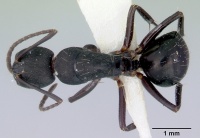Camponotus rudis
| Camponotus rudis | |
|---|---|

| |
| Scientific classification | |
| Kingdom: | Animalia |
| Phylum: | Arthropoda |
| Class: | Insecta |
| Order: | Hymenoptera |
| Family: | Formicidae |
| Subfamily: | Formicinae |
| Tribe: | Camponotini |
| Genus: | Camponotus |
| Species: | C. rudis |
| Binomial name | |
| Camponotus rudis McArthur, 2003 | |
Nothing is known about the biology of Camponotus rudis.
Identification
McArthur (2003) - Similar to Camponotus lownei. Distinguished by finely and densely punctate integument whereas in C. lownei it is mostly finely reticulate; with 5-10 erect setae on underside of the head and propodeum whereas C. lownei has > 10. Declining surface of propodeum is longer than the dorsal surface, in both.
Keys including this Species
Distribution
Latitudinal Distribution Pattern
Latitudinal Range: -33.08332825° to -33.08333333°.
| North Temperate |
North Subtropical |
Tropical | South Subtropical |
South Temperate |
- Source: AntMaps
Distribution based on Regional Taxon Lists
Australasian Region: Australia (type locality).
Distribution based on AntMaps
Distribution based on AntWeb specimens
Check data from AntWeb
Countries Occupied
| Number of countries occupied by this species based on AntWiki Regional Taxon Lists. In general, fewer countries occupied indicates a narrower range, while more countries indicates a more widespread species. |

|
Estimated Abundance
| Relative abundance based on number of AntMaps records per species (this species within the purple bar). Fewer records (to the left) indicates a less abundant/encountered species while more records (to the right) indicates more abundant/encountered species. |

|
Biology
Castes
Nomenclature
The following information is derived from Barry Bolton's Online Catalogue of the Ants of the World.
- rudis. Camponotus rudis McArthur, 2003: 11, figs. 9, 16 (s.w.) AUSTRALIA (New South Wales).
- Type-material: holotype minor worker, 2 paratype minor workers.
- Type-locality: holotype Australia: New South Wales, Condobolin, 33°05’S, 147°09’E, 11.i.1967 (B.B. Lowery); paratypes with same data.
- Type-depositories: ANIC (holotype); ANIC, SAMA (paratypes).
- Status as species: McArthur, 2007a: 339; McArthur, 2010: 70; McArthur, 2014: 134.
- Distribution: Australia.
Unless otherwise noted the text for the remainder of this section is reported from the publication that includes the original description.
Description
Worker
Major worker. Head sides and vertex mostly straight; clypeus anterior margin median section forming two projecting lobes with a concavity between; metanotum very wide.
Minor worker. Head sides straight and mostly parallel, vertex rounded, eyes placed at posterior third of the head; clypeus with a few long erect setae, sparse pubescence, anterior margin projecting convex; mesosoma dorsum evenly convex, propodeum angle in rear view very narrow.
Type Material
- Holotype, minor worker, Condobolin, 33°05'S 147°09'E, New South Wales, Australia, 33°05′0″S 147°09′0″E / 33.083333°S 147.15°E, Lowery,B.B., ANIC32-023591, Australian National Insect Collection.
- Paratype, 2 workers, Condobolin, 33°05'S 147°09'E, New South Wales, Australia, 33°05′0″S 147°09′0″E / 33.083333°S 147.15°E, Lowery,B.B., ANIC32-023593, Australian National Insect Collection.
- Paratype, minor worker, Condobolin, 33°05'S 147°09'E, New South Wales, Australia, 33°05′0″S 147°09′0″E / 33.083333°S 147.15°E, South Australian Museum.
Etymology
So named because of the fine dense punctations from Latin rudis; rough, unpolished.
References
- Heterick, B.E. 2021. A guide to the ants of Western Australia. Part I: Systematics. Records of the Western Australian Museum, Supplement 86, 1-245 (doi:10.18195/issn.0313-122x.86.2021.001-245).
- Heterick, B.E. 2022. A guide to the ants of Western Australia. Part II: Distribution and biology. Records of the Western Australian Museum, supplement 86: 247-510 (doi:10.18195/issn.0313-122x.86.2022.247-510).
- McArthur, A.J. 2003. New species of Camponotus (Hymenoptera: Formicidae) from Australia. Transactions of the Royal Society of South Australia. 127(1):5-14. (page 11, figs. 9, 16 minor, major described)

